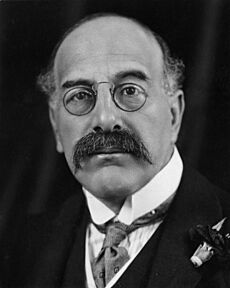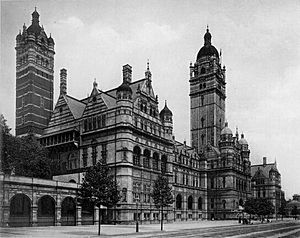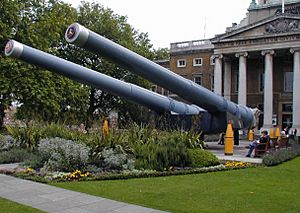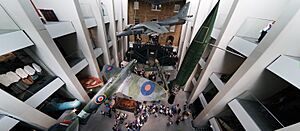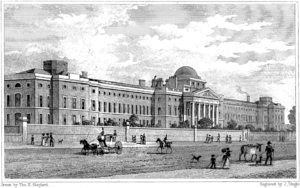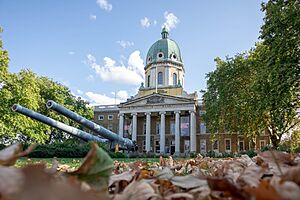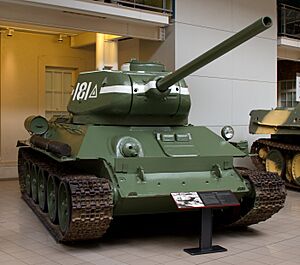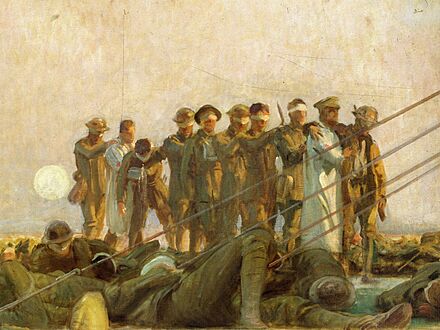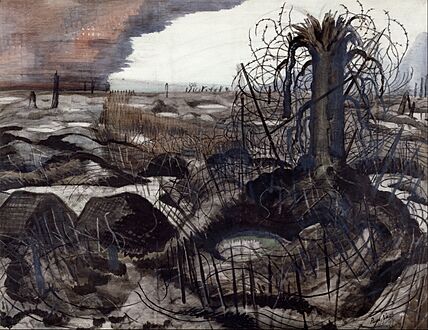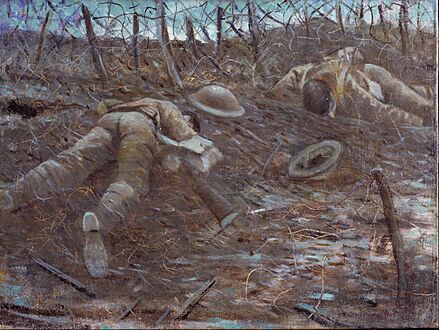Imperial War Museum facts for kids
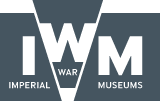 |
|
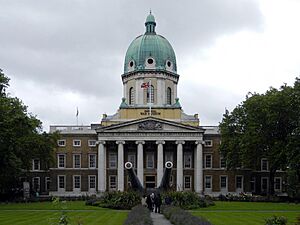
Imperial War Museum London
|
|
| Established | 1917 (branches opened 1976, 1978, 1984 and 2002) |
|---|---|
| Location | IWM London: Lambeth Road, London IWM Duxford: Duxford, Cambridgeshire HMS Belfast: The Queen's Walk, London Churchill War Rooms: Clive Steps, King Charles Street, London IWM North: The Quays, Trafford Wharf Road, Manchester |
| Collection size | 33,000,000 archival items, 435,589 museum items |
| Visitors | All branches: 2,667,926 IWM London: 1,073,936 IWM Duxford: 401,287 HMS Belfast: 327,206 Churchill War Rooms: 620,933 IWM North: 244,564 |
| Public transit access | |
| Imperial War Museums | |
|
|
The Imperial War Museums (IWM) is a group of national museums in Britain. They have five locations across England, with their main office in London. The museum started in 1917 to keep records of Britain's efforts and sacrifices during the First World War.
Over time, the museums began to cover all conflicts involving British or Commonwealth forces since 1914. Today, their goal is to help people study and understand the history of modern war and what it was like to live through wartime.
The first museum opened in 1920 at the Crystal Palace. It moved a few times before finding a permanent home in 1936. This building, a former hospital, is now the main IWM London site. When the Second World War started, the museum collected even more items.
Since the 1970s, IWM has opened several new branches. These include Imperial War Museum Duxford (an airfield museum), HMS Belfast (a real warship), the Churchill War Rooms (an underground bunker), and Imperial War Museum North in Manchester. The London museum has also had many updates, with the latest completed in 2022.
IWM has huge collections, including personal letters, official documents, photos, films, and recordings of people's stories. They also have a large library, an art collection, and many military vehicles, aircraft, and other items.
Contents
How the Museum Started
The Idea for a Museum: 1917–1921
In 1917, a politician named Sir Alfred Mond suggested creating a National War Museum. The government agreed, and the idea was announced in a newspaper. A committee was formed to collect items for the new museum.
This committee gathered materials to show Britain's war efforts. They looked at the Army, Navy, how weapons were made, and the important roles women played. They wanted the exhibits to show people's personal experiences, not just old objects. Sir Martin Conway, the museum's first director, said exhibits should show "the action, the experiences, the valour and the endurance of individuals." In December 1917, the museum's name changed to the Imperial War Museum.
King George V officially opened the museum at the Crystal Palace on June 9, 1920. Sir Alfred Mond said he hoped everyone who took part in the war would find something that showed their sacrifice. He also said the museum was "not a monument of military glory, but a record of toil and sacrifice." Soon after, a law was passed to create a board of trustees to manage the museum. By November 1921, over 2.2 million people had visited.
Moving to a New Home: 1924–1936
In 1924, the museum moved to the Imperial Institute in London. This location was more central, but the space was too small. In 1936, the museum found a permanent home south of the River Thames in Southwark.
The new building was once the Bethlem Royal Hospital. A wealthy man named Lord Rothermere bought the site. He planned to create a public park. However, the central part of the hospital building was saved. The two large wings were removed, and the park was named Geraldine Mary Harmsworth Park after Lord Rothermere's mother. The Duke of York (who later became King George VI) reopened the museum in its new home on July 7, 1936.
World War II and Beyond: 1939–1966
When the Second World War began in 1939, the museum started collecting items from this new conflict. During the war, some of the museum's old artillery pieces were even returned to military service. The museum closed to the public in September 1940 because of the Blitz (bombing raids on London). In January 1941, a German bomb hit the museum, damaging some exhibits.
After the war, the museum slowly reopened its galleries. In 1953, it began collecting items from all modern conflicts involving British or Commonwealth forces. This included wars in Korea and Malaya.
Growing and Changing: 1966–2012
In 1966, the London museum building was expanded. It added more storage and a new cinema. In 1967, the museum got two huge 15-inch naval guns, which had been used in the Second World War. They went on display outside the museum in 1968. These guns led the museum to think about getting a whole warship, which eventually happened with HMS Belfast.
In 1969, a former Royal Air Force airfield called Duxford became available. The museum needed more space, so it took over the site. In 1976, Imperial War Museum Duxford opened as the museum's first branch. In 1978, HMS Belfast, a Royal Navy cruiser, became a branch of the museum.

The government also suggested the museum take over the historic Cabinet War Rooms, an underground command center. The museum agreed, and the Churchill War Rooms opened to the public in 1984.
The London museum building had a big renovation from 1986 to 1989. The old courtyard was turned into a large gallery for big exhibits like tanks and aircraft. This new space was very impressive. In 1990, the museum won the National Heritage Museum of the Year award.
In 2002, Imperial War Museum North opened in Manchester. This was the fifth branch and the first outside southeast England. In 2011, the museum officially changed its name to Imperial War Museums to reflect its many locations.
Remembering World War I: 2014
In 2010, plans were announced to update the London museum's First World War gallery for the conflict's 100th anniversary in 2014. Prince William, Duke of Cambridge became a supporter of this project. The £40 million renovation created new galleries, a new central hall, and improved visitor areas.
IWM London closed for renovations in January 2013 and officially reopened on July 17, 2014. The new atrium features impressive exhibits like a Supermarine Spitfire and a V-2 rocket.
Like many places, all Imperial War Museum sites closed to the public for periods in 2020 and 2021 due to the COVID-19 pandemic.
Museum Locations
Since the 1970s, the Imperial War Museum has expanded to several different sites.
Imperial War Museum London
The main museum, IWM London, is in the former Bethlem Royal Hospital building. This building was designed in 1814 and later changed in 1835. A copper dome was added in 1846.
When the museum moved in 1936, the building was set up with galleries for the Navy, Army, and Air Force. There were also art galleries and exhibits about women's war work. The building is now a protected historic site.
Today, the original hospital building mostly holds offices. Newer parts, built in the 1960s and 1980s, house the library, art storage, and exhibition spaces. The museum has galleries on the First and Second World Wars, and conflicts after 1945.
One special gallery is the Lord Ashcroft Gallery, which opened in 2010. It displays the museum's collection of Victoria Cross (VC) and George Cross medals. These are the highest awards for bravery in the UK. The Lord Ashcroft Collection will close on June 1, 2025.

In October 2021, new galleries about the Holocaust opened at the London site. These galleries explain the Holocaust and its importance in World War II.
Imperial War Museum Duxford
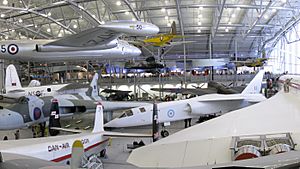
IWM Duxford, in Cambridgeshire, is Britain's largest aviation museum. It holds nearly 200 aircraft, military vehicles, and other large exhibits in seven main buildings. It also stores many of the museum's films, photos, and documents.
Duxford was an active Royal Air Force (RAF) airfield during both World Wars. It played a key role in the Battle of Britain in World War II. Many of its original buildings are still used today. The site also has modern exhibition buildings, like the American Air Museum. Duxford is still an active airfield and hosts regular air shows.
HMS Belfast (1938)
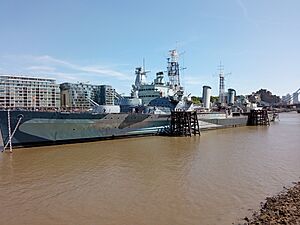
HMS Belfast is a real warship launched in 1938. She fought in the Second World War and the Korean War. After being taken out of service in 1963, people wanted to save her as a museum.
In 1971, the ship was saved and brought to London. She is now moored on the River Thames near Tower Bridge. Belfast became a branch of the Imperial War Museum in 1978. She shows what life was like on a warship and represents an important part of naval history. In 2017, the exhibit's name changed to "HMS Belfast 1938."
Churchill War Rooms
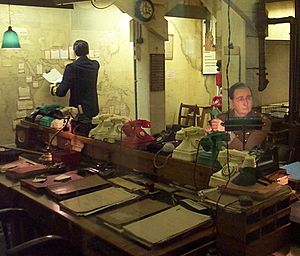
The Churchill War Rooms are an underground complex in London. They served as a secret British government command center during the Second World War. These rooms were used constantly from 1939 until the war ended in 1945.
Their historical importance was quickly recognized. In 1982, the museum agreed to take over the site, with strong support from Prime Minister Margaret Thatcher. The War Rooms opened to the public in April 1984. In 2003, more rooms, including those used by Winston Churchill, were added. In 2005, a museum about Churchill's life was also created within the War Rooms.
Imperial War Museum North
Imperial War Museum North opened in Manchester in 2002. It was the first branch of the museum built outside southeast England. The building was designed by architect Daniel Libeskind. His design was inspired by a globe shattered by conflict and then put back together. The building's shape represents earth, air, and water.
The museum's main gallery has permanent exhibitions that tell the story of war through time. It also has six themed displays. The walls of the gallery are used to project a large audiovisual show called the "Big Picture." Exhibits include a Russian T-34 tank and a British field gun that fired the first shot of the First World War.
Museum Collections
The Imperial War Museum collects and preserves many different types of items related to modern warfare.
Documents and Records
The museum keeps private papers from people who experienced modern wars. This includes letters, diaries, and memoirs from soldiers and civilians. It also has official documents and collections of foreign papers, like captured German documents from World War II. The archive also includes information on war memorials in the UK. In 2012, the museum had 24,800 collections of papers.
Art Collection
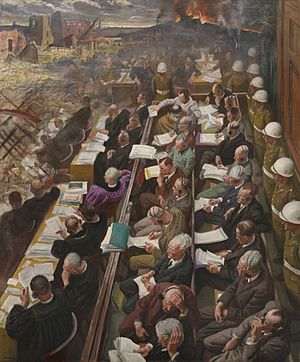
The museum's art collection includes paintings, drawings, sculptures, and works in film and photography. It started during the First World War with commissioned artworks. By 1920, it had over 3,000 works by famous artists like John Singer Sargent. The collection grew even more after the Second World War.
The museum also commissions artists to create works about current conflicts. This helps to capture modern experiences of war. The collection also has over twenty thousand posters and other publicity materials from both World Wars. In 2012, the art collection had 84,980 items.
Film and Video
The museum's Film and Video Archive is one of the oldest in the world. It holds important films and videos, including official British films from the First World War. One famous film is The Battle of the Somme (1916), which is recognized by UNESCO.
The archive also has unedited film from British military cameramen in World War II, showing events like D-Day and the liberation of concentration camps. It also includes government information films and propaganda. The archive continues to receive materials from the Ministry of Defence. In 2012, the archive had over 23,000 hours of film and video.
Photographs
The museum's Photograph Archive has photos from official, amateur, and professional photographers. It includes the official British photographic records of both World Wars. The First World War collection has 150,000 aerial photographs, the largest collection of its kind.
The Second World War collection includes works by famous photographers like Cecil Beaton. The archive continues to receive materials from the Ministry of Defence. In 2012, the museum had about 11 million images in its photo collection.
Physical Exhibits
The museum's exhibits collection includes many different objects. These are organized into smaller collections like uniforms, badges, medals, and flags. It also has military equipment, firearms, weapons, vehicles, aircraft, and ships.
The museum has the national collection of modern firearms. This includes a rifle used by T. E. Lawrence and a pistol owned by Winston Churchill. The vehicle collection includes Ole Bill, a bus used in the First World War, and vehicles used by Field Marshal Montgomery in World War II.
The aircraft collection has rare planes, like the only complete Royal Aircraft Factory R.E.8 in existence. It also has planes famous for their actions, such as a Supermarine Spitfire flown during the Battle of Britain. The naval collection includes small boats and a midget submarine. In 2012, the museum had 155,000 objects and 357 vehicles and aircraft.
Library
The museum's library is a national resource for modern conflict. It has books on all parts of warfare, including unit histories, technical manuals, and biographies. It also holds printed items like leaflets, ration books, newspapers, and trench maps. In 2012, the library had over 80,000 important historical items and 254,000 reference materials.
Sound Recordings
The museum's Sound Archive has 33,000 sound recordings. This includes a large collection of oral history recordings from people who experienced conflicts since 1914. The sound collection opened to the public in 1977.
It also has recordings made by the BBC during World War II, sound effects, broadcasts, speeches, and poetry. The museum produces a podcast series called Voices of the First World War, using its oral history recordings. In 2012, the sound collection had 37,000 hours of recordings.
Online Databases
IWM has an online database where you can search for items in its collections. Some items have images that can be shared under a Creative Commons license.
The War Memorials Register is a database of war memorials in the UK. It records details like what they are made of, their condition, and their location. It covers memorials for all conflicts, with over 90,000 memorials listed as of 2022.
In 2014, IWM launched "Lives of the First World War" with Findmypast. This platform allowed people to add records and build profiles for individuals who lived during the First World War. The goal was to create a "permanent digital memorial" using information from many sources. The data from this platform became part of the IWM archive in 2019 and is now free to access online for research.
Selected Collection Highlights
How the Museum is Run
The Imperial War Museum is a public body supported by the government. A Board of Trustees manages the museum. The board includes a president, who is currently Prince Edward, Duke of Kent, and fourteen other members. Seven more members are Commonwealth High Commissioners from different countries.
The museum's director-general reports to the trustees. Since 1917, there have been six directors. The first was Sir Martin Conway. The current director-general is Caro Howell, who started in May 2023.
See also
 In Spanish: Museo Imperial de la Guerra para niños
In Spanish: Museo Imperial de la Guerra para niños


